
Migraine is a common and disabling headache disorder. Painful migraine headaches frequently affect people between the ages of 18 and 44. Many common medication treatments for migraine may cause side effects that are difficult to tolerate, and can lead people to not take their medications as recommended, or to stop taking them altogether. A recent study suggests that up to 20% of patients with migraine have used opioids to treat their pain in the past year. Therefore, there is a great need for better and more tolerable treatments for people who have migraines.
Research has shown that combining behavioral treatments with preventive medication treatments works better for preventing headaches than medications alone. Mindfulness practice has also been associated with improvements in individuals with chronic pain, including migraine. Mindfulness is the mind-body treatment that involves purposely focusing one’s attention on the present momentary awareness and accepting it without judgment.
Stress is a well-known trigger for migraine. Moreover, stressful events have been associated with people experiencing more frequent or chronic migraines versus having them occasionally. Mindfulness can result in stress reduction, reduced emotional response to stress, and improved general happiness. In patients with migraine, pain severity and unpleasant symptoms can be reduced with this treatment.
Mindfulness can potentially strengthen emotional and cognitive control of pain by helping to train someone with migraine to reassess their pain in a nonjudgmental way and modify their evaluation of the pain. In addition, mindfulness practices can help to control depression, anxiety, and pain catastrophizing (an exaggerated negative feeling toward pain experiences), which can play a role in chronic migraine.
The study
In a recent study published in JAMA, a group of researchers investigated whether mindfulness-based stress reduction may provide benefit for people experiencing migraine. The study randomly assigned half of participants with migraine to the mindfulness treatment and the other half to only headache education.
The mindfulness-based stress reduction treatment incorporated eight weeks of two-hour, in-person classes, which included sitting and walking meditation, body scanning (sequential attention to parts of the body), and mindful movement (bodily awareness during gentle stretching using hatha yoga), bringing attention back to the natural rhythm of the breath. In addition, the study participants were encouraged to build their capacity to address physical and mental perceptions of their pain, and they were provided audio files for at-home practice.
The headache education treatment included a standardized protocol of eight weeks of two-hour, in-person classes that contained education about the biological, psychological, and environmental processes associated with migraines, headache triggers, and stress. The patients were also given time for questions, answers, and discussion during each class.
The results
The researchers demonstrated that mindfulness-based stress reduction treatment significantly improved people’s disability, quality of life, self-efficacy, pain catastrophizing, and depression compared to patients who only had headache education. Reductions in monthly migraine days were observed in those with mindfulness-based stress reduction treatment, but were not significantly different from those receiving headache education. The authors of the study explain that the reason they could not demonstrate improvement in the headache frequency could be the use of an active control group such as headache education, which itself may result in improvement of headache frequency.
Most importantly, the study demonstrated that mindfulness-based treatments can reduce the burden of migraine. With mindfulness, the participants of the study may have learned a new way of processing pain that may have a significant effect on their long-term health. The results of this study have major implications for both patients and clinicians, and the research can support a holistic, integrative treatment plan for patients with migraine, with less emphasis on nonmedical treatments.
What you can do
Many healthcare providers, including headache specialists, pain specialists, neurologists, and primary care physicians, have started to incorporate mindfulness-based treatment in their practices, or they have sought mindfulness-based programs or specialists for their patients.
There are also many ways for patients with migraine to practice mindfulness at home. Patients with migraine can integrate some of the following mindfulness-based practices in their daily life, including during a migraine headache:
- Accept yourself, your present moment.
- Lie on your back or in a comfortable position with no distractions, and direct your awareness to your body and breathing. Scan your body and observe your feet, legs, hands, arms, and other parts of your body.
- Try to sit down in a comfortable and quiet place, close your eyes, take a deep breath. Try to do breathing exercises, paying attention to the sensations of your breath while inhaling and exhaling.
- Sitting or walking meditation done outside in nature may be very relaxing. Focus on the experience of walking, being aware of the sensations of standing and the subtle movements that keep your balance.
Resources
There many are apps and quality resources for mindfulness and migraine learning and practice. Here are few online resources to explore:
Body scan mindfulness exercise for pain (Harvard Health Publishing)
Mindfulness Meditation for Migraine (American Migraine Foundation)
Mindfulness series for Migraine & Headache Disorders (Miles for Migraine)
Mindfulness and Migraine (National Headache Foundation)
